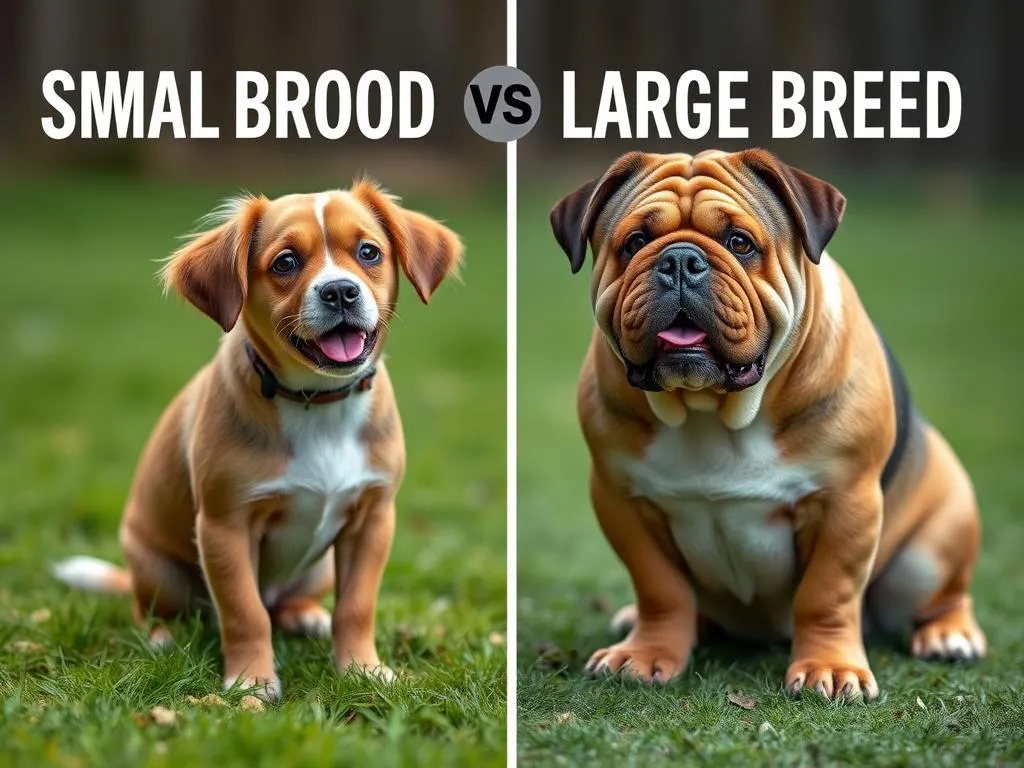
Introduction
Overview of Dog Breeds
Dog breeds vary significantly in size, temperament, and nutritional requirements. They are generally classified into three categories based on size: small breed dogs, regular breed dogs, and large breed dogs. Understanding these classifications helps dog owners provide appropriate care, particularly when it comes to nutrition.
Purpose of the Article
This article aims to explore the differences in nutritional needs between small breed dog food, regular breed dog food, and large breed dog food. By shedding light on these distinctions, we hope to empower dog owners to make informed decisions about their pets’ diets.
Importance of Nutrition in Dog Breeds
Proper nutrition is critical for all dog breeds, affecting their health, growth, and longevity. Each breed has unique dietary needs that must be met to ensure overall well-being and prevent health issues.
Understanding Dog Breeds
Classification of Dog Breeds
Dog breeds are defined by specific traits, genetics, and purposes. Generally, they are classified into various groups, such as working, sporting, herding, hound, and toy breeds. Each group has its own unique characteristics, behaviors, and care requirements. The size categories—small, medium, and large—are essential for understanding how to cater to their distinct nutritional needs.
Characteristics of Small Breed Dogs
Small breed dogs, such as the Chihuahua and Pomeranian, typically weigh less than 20 pounds. These breeds often have high energy levels and unique temperament traits such as being lively and sometimes even feisty. Lifespan for small breeds tends to be longer, often reaching 12 to 16 years, but they can be prone to specific health issues, including dental problems and obesity.
Characteristics of Regular and Large Breed Dogs
Regular breed dogs, like Beagles, usually weigh between 20 and 50 pounds, while large breeds such as Labrador Retrievers exceed 50 pounds. Regular breeds often have moderate energy levels and are generally friendly and sociable. In contrast, large breeds may exhibit more protective behaviors but require a strong owner to guide them. Lifespan for regular breeds is around 10 to 15 years, while large breeds typically have shorter lifespans, often averaging 8 to 12 years, and they may face health issues like hip dysplasia and heart problems.
Nutritional Needs by Size
Overview of Nutritional Requirements
Balanced nutrition is crucial for all dog breeds. Key nutrients such as proteins, fats, carbohydrates, vitamins, and minerals are vital for maintaining health. Each size category has specific nutritional needs tailored to their metabolic rates, growth patterns, and potential health issues.
Small Breed Dog Food
Small breed dogs have unique dietary needs primarily due to their higher metabolic rates. They require caloric density in their food to maintain energy levels. This means their food should be energy-rich, often necessitating a higher protein and fat ratio compared to larger breeds.
Recommended Ingredients and Brands
When selecting small breed dog food, look for products that contain high-quality proteins, healthy fats, and easily digestible carbohydrates. Brands like Royal Canin and Wellness offer specialized formulas for small breed dogs.
Common Misconceptions About Small Breed Diets
A common misconception is that small breed dogs can consume the same food as larger breeds in smaller portions. This is not true; their nutritional requirements differ significantly, and feeding them inappropriate food can lead to health issues.
Regular Breed Dog Food
Regular breed dogs require a balanced caloric intake with a focus on maintaining a healthy weight. Their diets should include a mix of proteins, fats, and carbohydrates, along with adequate fiber for digestive health.
Recommended Ingredients and Brands
Look for regular breed dog food that features a balanced nutrient profile. Brands like Blue Buffalo and Nutro provide options that cater to the needs of regular breed dogs, offering a well-rounded mix of ingredients.
Differences from Small and Large Breed Diets
Unlike small breed diets, which focus on energy density, regular breed diets provide a moderate calorie count to support their energy needs without leading to obesity. They also incorporate fiber to aid digestion, which is less emphasized in small breed diets.
Large Breed Dog Food
Large breed dogs have unique dietary requirements, particularly concerning joint health. They often need food formulated to promote slow and steady growth, helping to reduce the risk of musculoskeletal issues.
Recommended Ingredients and Brands
For large breed dogs, look for food that contains glucosamine and chondroitin for joint support. Brands like Hill’s Science Diet and Purina Pro Plan offer specially formulated large breed diets that focus on these aspects.
Common Issues with Feeding Large Breeds
Many dog owners mistakenly overfeed large breeds, which can lead to rapid growth and associated health issues. It’s crucial to follow feeding guidelines to ensure a healthy growth rate.
Feeding Guidelines
General Feeding Guidelines for All Breeds
Portion control is essential for all breeds to prevent obesity and other health problems. Feeding frequency can vary based on the dog’s age, with puppies typically requiring more frequent meals than adult dogs.
Specific Guidelines for Small Breed Dogs
Small breed dogs usually require about 40 calories per pound of body weight daily. Their ideal feeding schedule includes two to three meals per day with controlled portion sizes to maintain their energy levels without leading to obesity.
Specific Guidelines for Regular Breed Dogs
Regular breed dogs generally need around 30 calories per pound of body weight. An ideal feeding schedule consists of two meals per day, ensuring that portions are balanced to meet their energy needs and maintain a healthy weight.
Specific Guidelines for Large Breed Dogs
Large breed dogs require about 20 to 30 calories per pound of body weight, depending on their activity level. Their feeding schedule should also include two meals per day, but it’s important to monitor portion sizes closely to prevent rapid growth.
Transitioning Between Dog Foods
When to Transition Dog Food
Dog owners may need to transition their pets to a different diet due to age, health changes, or dietary preferences. Signs that a dog may require a different diet include weight gain, increased lethargy, or digestive issues.
How to Transition Dog Food Safely
To transition dog food safely, gradually mix the new food with the old food over a week. Start with 25% new food and 75% old food, gradually increasing the new food ratio to avoid digestive issues. This gradual approach helps dogs adjust to the new diet without gastrointestinal upset.
Common Myths and Misconceptions
Myths About Small Breed Dog Nutrition
One prevalent myth is that small breed dogs can thrive on human food scraps. In reality, many human foods can be harmful to small breeds, making it essential to provide a balanced diet specifically formulated for their needs.
Myths About Large Breed Dog Nutrition
Another misconception is that large breed puppies should be fed high-protein diets to promote rapid growth. This can lead to serious health issues; large breeds benefit from controlled protein levels that support gradual growth.
Conclusion
Understanding the nutritional needs of different dog breeds is vital for their health and well-being. Each size category—small, regular, and large—has unique dietary requirements that should be met to ensure a long, healthy life. We encourage all dog owners to consult with veterinarians for tailored dietary advice, as proper nutrition significantly impacts overall health.
By adhering to the guidelines and debunking common myths surrounding dog nutrition, owners can provide the best possible care for their furry companions.
FAQs
Q: Can small breed dogs eat large breed dog food?
A: No, small breed dogs have different nutritional needs and should be fed food specifically formulated for them.
Q: How often should I feed my large breed dog?
A: Large breed dogs should be fed two meals per day to help regulate their growth and prevent obesity.
Q: Are there any safe human foods for dogs?
A: Yes, certain human foods like plain cooked chicken or carrots can be safe for dogs, but it’s important to avoid toxic foods like chocolate, grapes, and onions.
Q: Do regular breed dogs have special dietary needs?
A: Yes, regular breed dogs require a balanced diet that includes adequate fiber and moderate calories to maintain a healthy weight.
Understanding the distinct nutritional requirements of various dog breeds helps ensure that your pet leads a happy, healthy life.









